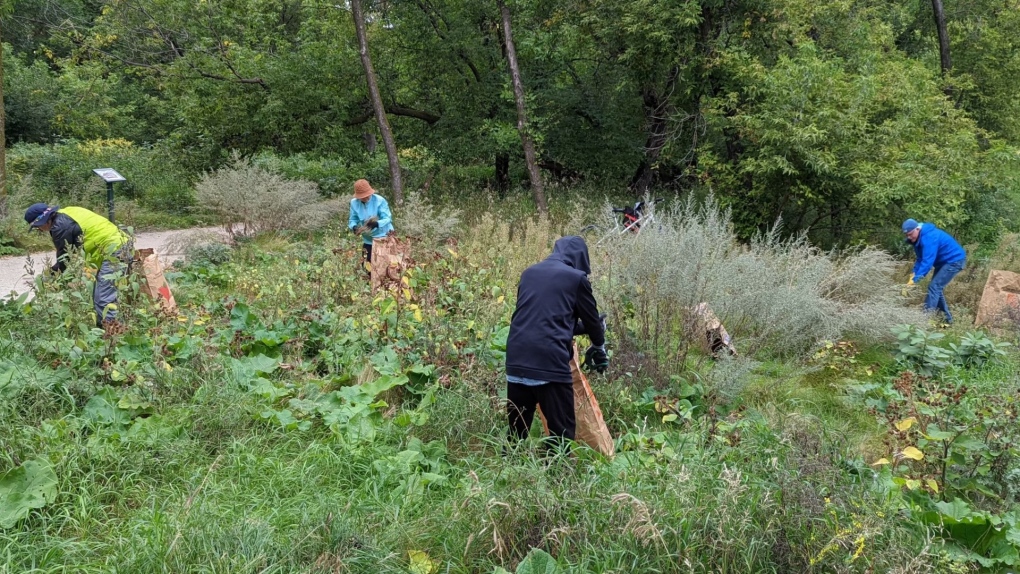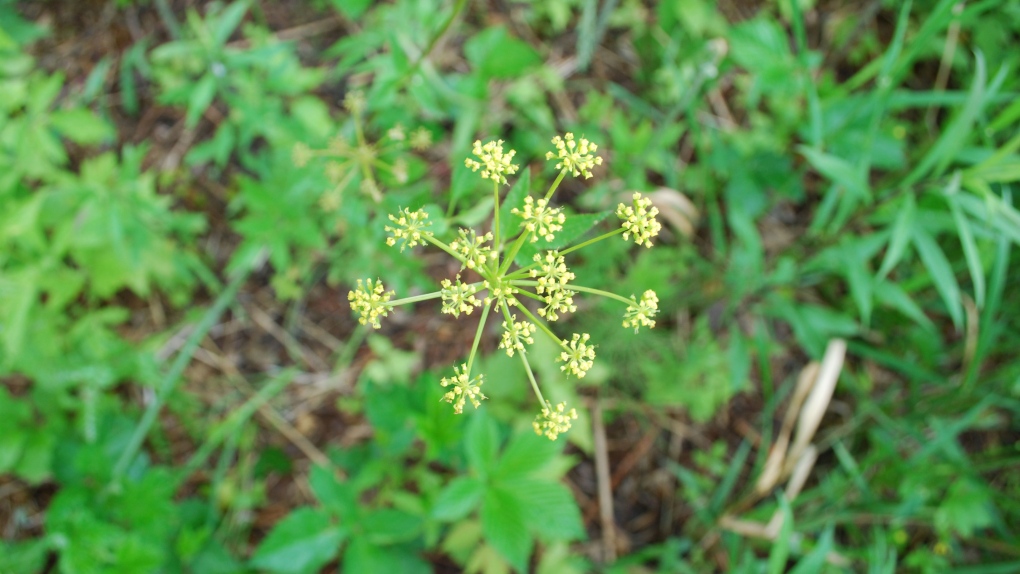'Get rid of them': The invasive plant species in Manitoba
 Save Our Seine is a non-profit organization that works to maintain a healthy ecosystem along the Seine River. Palmquist said volunteers regularly go out to remove any invasive plants they can find. (Source: Save Our Seine)
Save Our Seine is a non-profit organization that works to maintain a healthy ecosystem along the Seine River. Palmquist said volunteers regularly go out to remove any invasive plants they can find. (Source: Save Our Seine)
Invasive plant species continue to be a problem in Manitoba, as communities work to rid their green spaces of the wrong kind of green.
Wild parsnip has been a problem in Steinbach for several years, prompting the city to post warning signs in parks and along paths. Russ Dyck, manager of Parks and Recreation with the city of Steinbach said they have a moderate wild parsnip infestation this year.
"Some plants have shown up again in a couple of more natural bush areas along pathways," said Dyck in an email to CTV News.
Wild parsnip looks like a large dill plant, with a green stalk and yellow blooms, and can grow up to six feet tall. Dyck said it can cause an itchy rash or blisters if it touches the skin. Anyone who touches wild parsnip should wash with soap and water right away.
Invasive plant species are also popping up more in Winnipeg.
"Probably the biggest ones we go after are burdock, buckthorn, and Canada thistle, which in spite of the name is not Canadian," said Ryan Palmquist, managing director of Save Our Seine.
"Go to any open or wild space in the Seine River greenway and you're going to find them," he added.
Burdock has rhubarb-style leaves and sharp, purple flowers with thistles. Buckthorn is a somewhat generic-looking plant that resembles a tree or bush. Canada thistle, also known as creeping thistle, is another prickly plant.
Invasive plants are species that did not originate in Manitoba, but were brought here from other parts of the world. Once established, they tend to choke out native plants and adversely affect the ecosystem.
 The wild parsnip is pictured.
The wild parsnip is pictured.
"They were brought here originally as decorative plants, they are no longer decorative plants," said Palmquist. "If you see one, get rid of them.
"It's essentially everywhere. In any wild and open space in the urban area… it's often the dominant form of life," he said.
Save Our Seine is a non-profit organization that works to maintain a healthy ecosystem along the Seine River. Palmquist said volunteers regularly go out to remove any invasive plants they can find.
"One of our volunteers…is at Kavanagh Park every Wednesday from 5 - 7 p.m. in old St. Boniface for the entire summer and into October," Palmquist said.
His group has been aggressively targeting several areas along the Seine. "Once you see them, you can't unsee them, and you're going to want to pull them out whenever you can."
Palmquist said the best time to pull invasive plants is after they flowered, but before they have gone to seed. Save Our Seine offers regular training sessions on what to look for when it comes to invasive species.
"We can show you, and teach you, and support you in removing it at a much larger scale, and in a much more effective way."
Dyck said the city of Steinbach has hired a local weed contractor to spray for wild parsnip.
CTVNews.ca Top Stories

Joe Biden pardons son Hunter Biden of gun, tax charges, despite promising not to
U.S. President Joe Biden announced Sunday that he pardoned his son Hunter Biden on gun, tax charges, despite previous promises that he would not do so.
Canada Post presents union with 'framework' to reach deal as strike continues
Canada Post has presented the union representing some 55,000 striking postal workers with a framework to reach negotiated agreements, the corporation said.
'Devastating': Missing Surrey, B.C. teen found dead, family says
The family of a missing 18-year-old, who was last seen in Surrey over a month ago, says there has been a tragic end to the search.
opinion Are you overpaying for subscriptions? It's time for an audit
From streaming platforms and apps to gym memberships and meal kits, subscriptions are convenient, but it's easy to overlook how much you're spending. Personal finance contributor Christopher Liew offers tips on how to audit your subscriptions to save money.
The best tips to prepare your car for the winter
Slippery or snow-covered roads, reduced visibility and bitter cold are all conditions that can make driving difficult and even dangerous during cold weather months. CAA spoke with CTV Morning Live this week on some of the best ways you can winterize your car.
PM Trudeau 'surprised' provinces unanimous on accelerated defence spending: Ford
Ontario Premier Doug Ford says his fellow provincial leaders are united in pushing for Canada to meet its NATO defence spending targets ahead of schedule, and that Prime Minister Justin Trudeau was "surprised" to hear it.
Stellantis CEO resigns as carmaker sales continue to slump
Stellantis CEO Carlos Tavares is stepping down after nearly four years in the top spot of the automaker, which owns car brands like Jeep, Citroën and Ram, amid an ongoing struggle with slumping sales.
'Wicked' star Marissa Bode speaks out against 'harmful' ableist comments made about her character
'Wicked' actress Marissa Bode posted a video on TikTok asking for kindness after receiving ableist comments on social media.
Poilievre calls for asylum seeker cap, border plan as U.S. tariff threat looms
Conservative Leader Pierre Poilievre has demanded the federal government present a plan before Parliament to beef up border security as U.S. president-elect Donald Trump threatens to impose stiff tariffs on Canada.


































